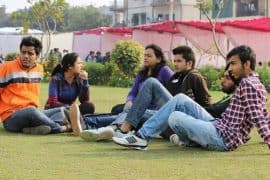Devi is a representation of absolute truth and an obsolete future, presented through nine women who share one common thread of past.
Priyanka Banerjee’s creation- Devi, is not a story, but truth brought into broad daylight. The film brings forth a shared truth of nine women from different walks of life. The setting is simple- a room filled with women. All seem to have engaged themselves- offering prayers, engrossing oneself in books, playing cards, trying to fix the television. The characters show the grim situation which is nothing but absolute truth. They seem to be engulfed in their respective coping mechanisms.
Bairi (Yashaswini Dayama) switches on the television- a popular song plays on the screen- Jiya Jaaye Naa. but contrary to the romantic overtones of the song, it seems to be a statement- Jiya Jaaye Naa (unable to live). Absence of life seems to resonate through the chorus of the song. Whether it is the living condition inside the room or the past of the characters, both signify the inability to live.
Before the plot unfolds, the room itself reflects a rhetoric value. The characters repeatedly ask about the number of people to be accommodated in the room, they feel suffocated, indicating that the room has finite space. The electricity fluctuation further raises the issue of burden. The room can hence be seen as a concrete translation of an abstract concept- tolerance. The ability to tolerate is finite, just like the capacity of the room. Patience and tolerance seem to be at a tipping end as the doorbell rings.
The channel suddenly changes to a news channel wherein a case of sexual assault is embossed on the headlines of the television, however, before the details are revealed, signal is lost. The headlines create tension in the room but before the viewers can know further the doorbell rings.
Four minutes into the short film, the viewers realise that there are skirmishes sparking off between the women inside the room as the doorbell rings repeatedly. Shivani Raghuvanshi’s character proposes the need for a proper system, this is where viewers’ curiosities are dissolved as it is revealed that the women are rape victims and have met death. At the end of the discussion no conclusion seems to arrive. This reflects another reality- rape is rape, a criminal offence that cannot be measured or compared.
There is an unusual relation between the women- forced sisterhood that does not come natural but is forced through the past. They know the gruesome truth but fail to empathise. Banerjee draws a parallel here- between the characters in the room and those in the society. The lacking empathy mirrors the society- a society which is unable to realise the ‘lopsided’ side.
At the end, Kajol’s character has to remind the other women of the day they entered to sensitise them as she walks to open the door.
“Yaad hai jab hum aaye the toh kitne darein huye the. (remember how scared we were when we first came here)”
A child enters, barely five or seven. As she enters the room, a state of speechlessness engulfs the room, a state of speechlessness engulfs the space that has a deafening effect. Devi ends in a complete circle. When Bairi switches the television a reporter asks concerning questions and as Devi ends, there are equally concerning truths.
Watch Priyanka Banerjee’s Devi here
Although Devi is gut-wrenching, it has uncanny resemblance to Abhishek Rai’s Four, a 2018 short film. The concept of both the films are identical. The parallels are heightened at the end as the endings are nearly the same.
Watch Abhishek Rai’s Four here
Feature Image Credits: YouTube
Priyanshi Banerjee
priyanshi3011banerjee




Comments are closed.